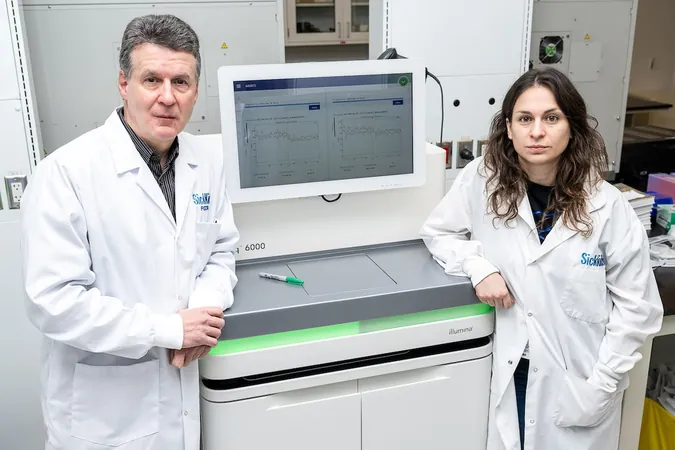
Is the First CRISPR Cure for Sickle Cell Disease Finally Here? The Journey of Deshawn “DJ” Chow
2024-12-23
Author: Jacob
Introduction
Deshawn “DJ” Chow, a 19-year-old brave warrior against sickle cell disease, embarked on a life-changing journey when he discovered a revolutionary treatment called Casgevy. Born with a condition that causes his red blood cells to take on a crescent shape, Chow experiences agonizing pain due to blocked blood vessels and limited oxygen supply. This debilitating disease impacts nearly 100,000 people in the U.S., predominantly affecting the Black community.
Chow's Struggles with Sickle Cell Disease
In high school, Chow’s frequent pain episodes led him to miss significant life events, including school and social activities. Painting a vivid picture of his struggle, Chow likened the pain to “my body being on fire.” His hopes soared when he learned about Casgevy, the first-ever approved gene-editing medication that utilizes CRISPR technology. Initially approved in late 2023 for treating sickle cell disease and approved for beta thalassemia this January, Casgevy represents a beacon of hope.
Challenges in the Rollout of Casgevy
However, since its approval, the rollout of Casgevy has faced significant hurdles. Complicated manufacturing processes, delays with insurance approvals, and the intricate preparations required for patients have resulted in a sluggish introduction. As a result, very few have received the treatment since it officially became available. While Vertex Pharmaceuticals and CRISPR Therapeutics, the companies behind Casgevy, remain tight-lipped about patient numbers, reports indicate only two hospitals out of 34 authorized centers in the U.S. have begun administering this groundbreaking treatment.
DJ Chow's Treatment Experience
Chow received his Casgevy infusion on December 5 at the City of Hope Cancer Center in Los Angeles, where he is also the first sickle cell patient to undergo this therapy. Leading up to his treatment, Chow's hematologist-oncologist, Dr. Leo Wang, explained that Casgevy is far more complex than traditional medications—it requires the collection and editing of a patient’s stem cells, followed by chemotherapy. This means a challenging regimen of recovery that keeps patients hospitalized for extended periods.
Clinical Trial Results and Patient Perspectives
In clinical trials, the results for Casgevy have been astounding. Among 42 patients tested, nearly all experienced a pain-free year after treatment with some enjoying up to five years without crises. “We’re at the dawn of a new age for sickle cell disease,” expressed Edward Donnell Ivy, chief medical officer of the Sickle Cell Disease Association of America. Yet, fear, skepticism regarding new gene-editing technologies, and historical mistrust in medical systems pose additional barriers for potential candidates seeking treatment.
Understanding the Treatment Process
Relying on the experiences of leaders in the field, many patients remain unaware of the extensive medical process involved in receiving Casgevy, causing hesitation. Unlike traditional methods like stem cell transplants—which require a compatible donor—Casgevy offers hope for freer access since it modifies a patient's own cells to combat the disease.
Challenges from Chemotherapy and Family Decisions
After a meticulous collection and blood processing journey, which may take weeks, Chow's cells were sent to Vertex for gene editing. This revolutionary edit aims to re-activate a dormant gene, promoting healthy hemoglobin production that could potentially cure sickle cell disease for life.
But it doesn’t come without challenges. Patients must undergo hefty doses of chemotherapy to create space for the modified stem cells, which can lead to discomfort, hair loss, and even infertility issues. Many families, like Chow's, must grapple with the balance between the potential for a pain-free future and the intense treatment process.
Healthcare Landscape and Economic Considerations
Navigating the healthcare landscape for Casgevy poses its own set of challenges, with its whopping price tag of $2.2 million making it pivotal to secure insurance before proceeding. Many hospitals are still refining processes and securing agreements with insurance providers, which creates delays in accessing the drug.
Hope for the Future
Despite the initial apprehensions and the slow rollout, the medical community remains hopeful for the future of Casgevy—and for patients like Chow. With music, creativity, and resilience, Chow is determined to use his hospital stay to pass the time, creating rap songs while working toward a pain-free life. He hopes to embrace new adventures, such as snowboarding, without fear of painful episodes.
Conclusion
With the general excitement slowly building and more treatment stories emerging, the future looks bright. "It’s all in God’s hands," says Chow, ready to chase a life filled with passion beyond pain. Can Casgevy and the evolving world of gene-editing finally provide a long-awaited cure for sickle cell disease? Only time will tell.









 Brasil (PT)
Brasil (PT)
 Canada (EN)
Canada (EN)
 Chile (ES)
Chile (ES)
 España (ES)
España (ES)
 France (FR)
France (FR)
 Hong Kong (EN)
Hong Kong (EN)
 Italia (IT)
Italia (IT)
 日本 (JA)
日本 (JA)
 Magyarország (HU)
Magyarország (HU)
 Norge (NO)
Norge (NO)
 Polska (PL)
Polska (PL)
 Schweiz (DE)
Schweiz (DE)
 Singapore (EN)
Singapore (EN)
 Sverige (SV)
Sverige (SV)
 Suomi (FI)
Suomi (FI)
 Türkiye (TR)
Türkiye (TR)